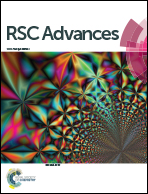Emulsion-polymerized flexible semi-conducting CNCs–PANI–DBSA nanocomposite films†
Abstract
We have developed an essentially green, bottom-up approach for synthesising flexible, organic, semi-conducting nanocomposite films based on cellulose nanocrystals (CNCs) and polyaniline (PANI) through aqueous emulsion polymerization. Dodecylbenzene sulfonic acid (DBSA) was used as surfactant and dopant for the emulsion. CNCs and DBSA micelle concentrations, their structural organization and alignment with the monomer in the emulsion have a significant effect on the physical and mechanical properties of the resulting nanocomposite films with electrical conductivity reaching as high as 5.29 × 10−1 S cm−1 which falls in the electrical conductivity range of germanium (2.24 × 10−2 S cm−1) and silicon (0.43 × 10−5 S cm−1) [S. L. Kakani, Electronics Theory and Applications, New Age International, 23–24, 2005]. The CNCs–PANI–DBSA nanocomposite films show a maximum tensile stress and strain values of 22 MPa and 0.89%, respectively and are significantly stronger and more flexible films than those obtained with, for instance, graphene/polyaniline composite paper or graphene paper, where it has been reported in the literature that the tensile strengths were 12.6 and 8.8 MPa, and maximum strains, 0.11 and 0.08%, respectively [Wang et al., ACS Nano, 2009, 3, 1745].


 Please wait while we load your content...
Please wait while we load your content...